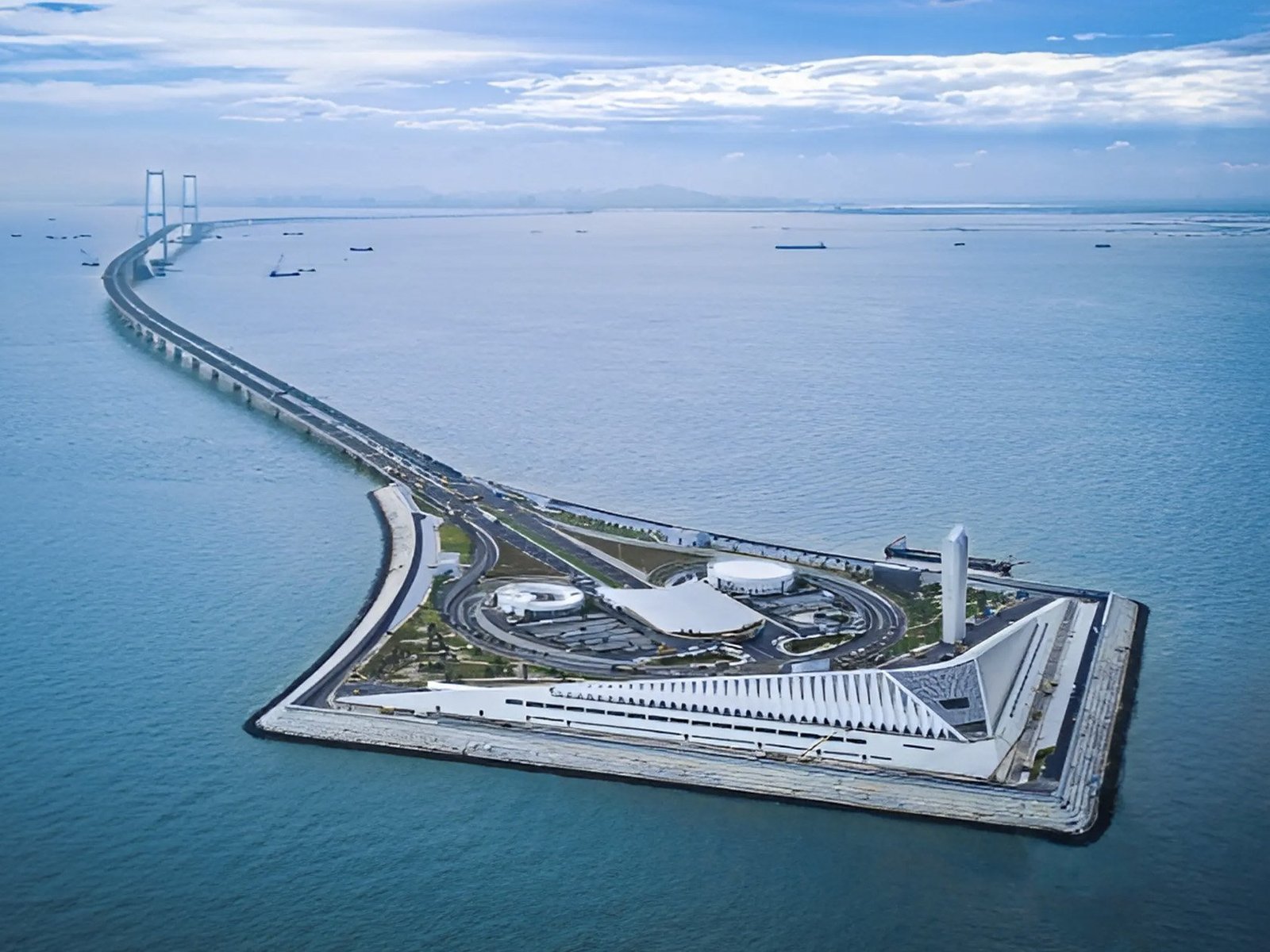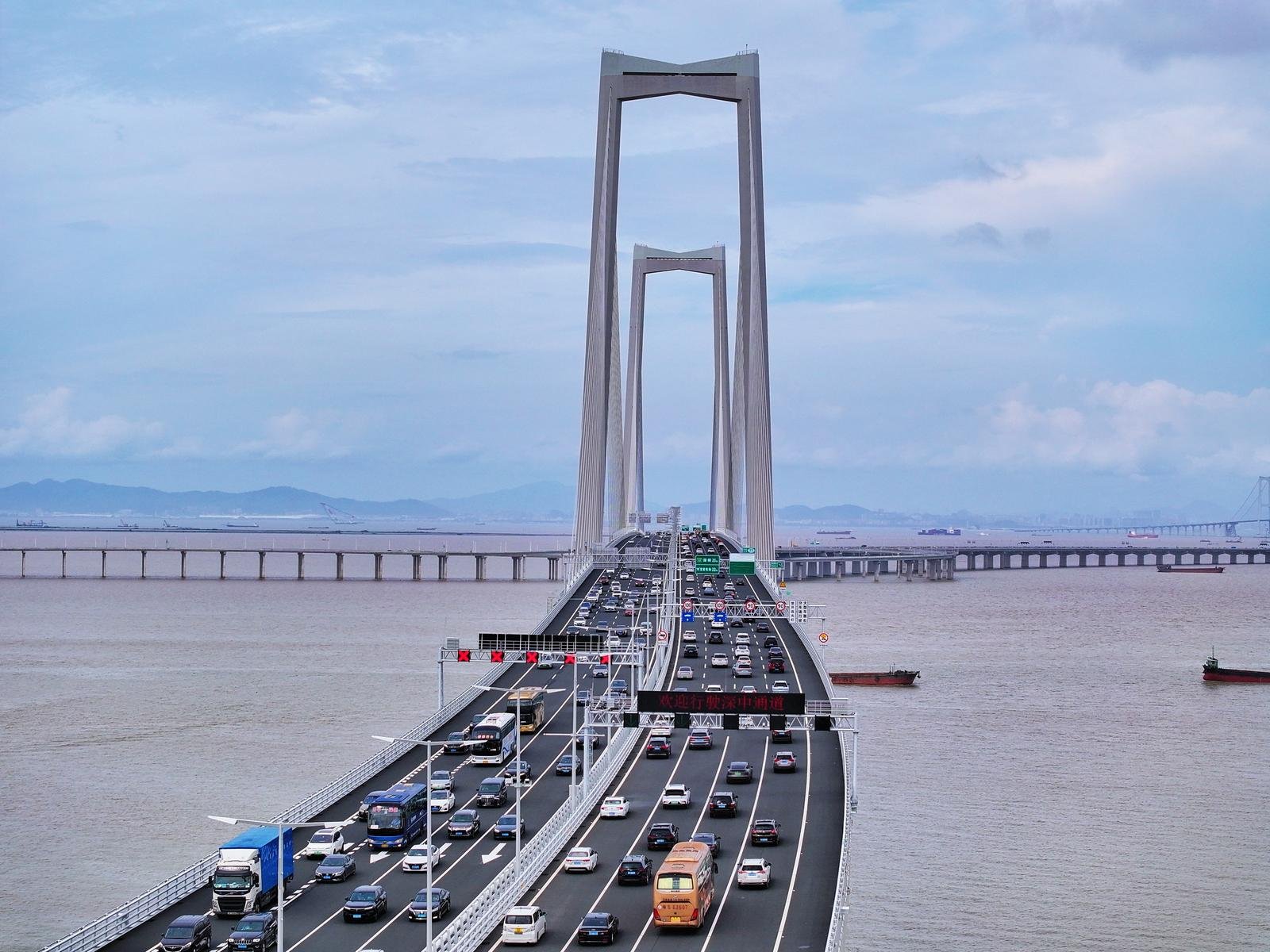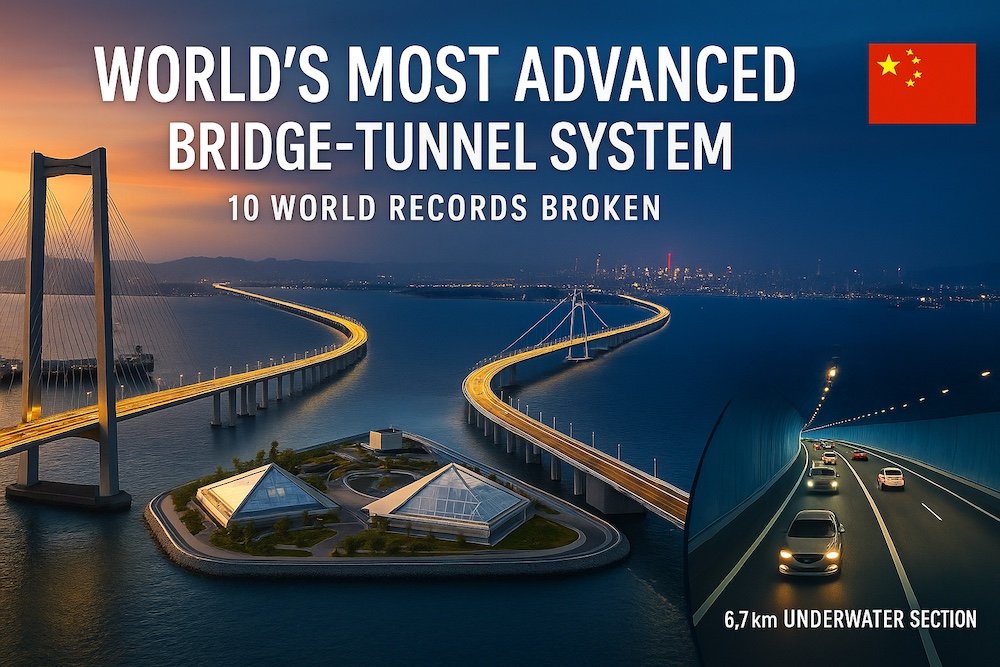Introduction: Engineering the Impossible
China has once again demonstrated why it leads the world in mega-infrastructure development. The recently completed Shenzhen-Zhongshan Link represents the pinnacle of engineering excellence. Moreover, this extraordinary project broke 10 world records simultaneously while transforming regional connectivity forever.
The $4.83 billion investment created a 24-kilometer transportation corridor that seemed impossible just decades ago. Additionally, the project reduced travel time between major cities from two hours to just 30 minutes. Furthermore, it showcases China’s ability to combine multiple advanced technologies into a single cohesive engineering marvel.
The Mega-Project That Defied Engineering Limits
Revolutionary Multi-Modal Design
The Shenzhen-Zhongshan Link represents a completely new approach to cross-sea transportation infrastructure. Rather than choosing between bridges or tunnels, Chinese engineers created an integrated system combining both technologies. Consequently, the project features a 6.7-kilometer underwater tunnel seamlessly connected to 19 bridges spanning 43 kilometers total.
The design accommodates the world’s busiest shipping lanes while maintaining minimal environmental impact. Additionally, the project navigates around Shenzhen International Airport’s flight paths with precision engineering. Furthermore, two artificial islands serve as transition points between underwater and above-sea sections.
Ten Simultaneous World Records
The project’s achievement of breaking 10 world records simultaneously demonstrates unprecedented engineering capabilities. According to Xinhua’s comprehensive analysis, these accomplishments include the world’s longest immersed tube tunnel, widest underwater steel-concrete structure, and highest offshore bridge clearance. Moreover, New Atlas provides detailed breakdowns of each record-breaking feat, including span length, tunnel dimensions, and wind resistance specifications.
Each record represents years of technological development and innovation. Additionally, the achievements establish new global standards for future mega-infrastructure projects. Furthermore, they demonstrate China’s systematic approach to pushing engineering boundaries across multiple domains simultaneously.
Technical Specifications That Shatter Conventional Limits
The Underwater Engineering Marvel

The tunnel section consists of 32 immersed tube elements, each measuring 165 meters in length and weighing approximately 80,000 tons. This represents the heaviest prefabricated underwater construction elements ever deployed globally. Moreover, the tubes feature a steel-concrete-steel composite structure that provides unprecedented strength and durability.
The positioning of these massive elements required millimeter-level precision at depths reaching 40 meters underwater. Consequently, Chinese engineers developed the world’s first integrated self-propelled transport-installation ship specifically for this project. Additionally, they introduced China’s BeiDou satellite navigation system for unmanned underwater installation procedures.
Bridge Engineering Excellence

The suspension bridge section features a main span of 1,666 meters, establishing the world record for fully offshore steel box girder suspension bridges. The bridge towers reach 270 meters in height while providing 76.5 meters of clearance – the highest in the world. Moreover, this clearance accommodates the largest container ships navigating Pearl River Delta waterways.
Construction of the bridge required innovative tower construction techniques adapted for complex marine environments. Additionally, the bridge withstands typhoons and seismic activity common to the region. Furthermore, integrated intelligent construction machinery ensured safe and efficient assembly in challenging offshore conditions.
Artificial Island Creation Technology

The project required creating two artificial islands totaling over 500,000 square meters of new land area. The western island alone covers approximately 137,000 square meters – equivalent to 19 international football fields. Moreover, Zhongshan Municipal Government documents detail how engineers completed island construction in less than six months using revolutionary techniques including intelligent robots and advanced monitoring systems.
Traditional island construction methods proved insufficient for the project’s challenging geological conditions. Consequently, engineers developed deep slurry mixing technology combined with vibrating-sinking installation of 57 giant steel cylinders, as outlined in CCCC’s technical reports. Additionally, each cylinder measures 28 meters in diameter and extends deep into the Pearl River seabed.
Revolutionary Construction Technologies
Underwater 3D Printing Innovation
Chinese engineers developed the world’s first “underwater 3D printer” – a gravel leveling ship capable of precise seabed preparation for tunnel installation. This innovative technology achieved full localization of both hardware and software components. Moreover, the system meets precise leveling requirements for various immersed tube specifications.
The technology demonstrates China’s commitment to developing proprietary solutions for complex engineering challenges. Additionally, it reduces dependency on foreign equipment while improving construction efficiency. Furthermore, the system’s precision capabilities exceed international standards for underwater construction projects.
BeiDou Satellite Integration
For the first time globally, engineers integrated China’s BeiDou satellite navigation system into immersed tube construction processes. People’s Daily Online details how this innovation enables unmanned installation procedures with unprecedented accuracy at extreme underwater depths. Moreover, the system provides real-time positioning data for massive construction elements while incorporating advanced robotic inspections and digital-twin control center technology.
The BeiDou integration represents a strategic technological advantage for China’s infrastructure development capabilities. Additionally, it demonstrates the practical applications of China’s space technology investments. Furthermore, the system’s success validates China’s approach to indigenous technology development across multiple sectors.
Smart Manufacturing Excellence
The project required establishing a smart factory in Zhuhai specifically for prefabricating immersed tunnel elements. After comprehensive upgrading, the facility successfully completed rapid prefabrication and transportation of 23 tunnel sections. Moreover, the factory developed 11 patented inventions during the construction process.
Advanced automation and quality control systems ensured precise manufacturing tolerances for massive concrete elements. Additionally, the facility integrated environmental protection measures throughout the production process. Furthermore, the smart factory demonstrates China’s advanced manufacturing capabilities for mega-infrastructure projects.
Economic Impact and Regional Transformation
Greater Bay Area Integration
The Shenzhen-Zhongshan Link serves as a crucial component of China’s Greater Bay Area development strategy. This ambitious plan aims to create an 86-million-person megalopolis rivaling major international economic centers. Moreover, the project directly connects three pilot free trade zones across the Pearl River Delta.
Enhanced connectivity facilitates economic integration between major manufacturing and technology hubs. Additionally, reduced transportation costs improve regional competitiveness in global markets. Furthermore, the project accelerates development of innovation zones on both sides of the Pearl River.
Traffic and Transportation Revolution

Initial usage statistics demonstrate immediate success, with CGTN reporting over 300,000 vehicles using the link within the first 72 hours of operation. The project now handles approximately 25% of daily Pearl River Delta traffic. Moreover, travel time reductions enable new commuting patterns and business relationships across the region.
Long-term projections estimate over 80,000 vehicles daily will utilize the enhanced connectivity. Additionally, the project reduces congestion on existing bridges and ferry systems. Furthermore, improved logistics capabilities strengthen the region’s position as a global manufacturing center.
Property Development and Urban Planning
The enhanced connectivity transforms property values and development patterns across connected regions. New residential and commercial developments emerge to capitalize on improved accessibility. Moreover, urban planning initiatives adapt to accommodate increased cross-river integration.
International businesses increasingly establish operations to leverage the improved transportation infrastructure. Additionally, tourism potential expands with enhanced access to previously isolated areas. Furthermore, the project becomes a destination itself, showcasing Chinese engineering capabilities to global visitors.
Environmental Innovation and Sustainability
Marine Ecosystem Protection
Despite the massive scale, environmental protection remained paramount throughout construction. Advanced monitoring systems tracked marine ecosystem impacts continuously during tunnel installation. Moreover, construction schedules accommodated marine life migration patterns and breeding seasons.
The closed-loop construction processes minimized sediment disturbance in sensitive Pearl River Delta waters. Additionally, habitat restoration programs offset unavoidable environmental impacts. Furthermore, long-term monitoring ensures ongoing ecosystem health throughout the project’s operational lifetime.
Advanced Materials and Longevity
The project incorporates cutting-edge materials science to ensure 100-year operational lifespans with minimal maintenance requirements. Steel-concrete-steel composite structures provide superior durability in marine environments. Moreover, advanced protective coatings prevent corrosion and structural degradation.
Energy-efficient operations reduce the project’s carbon footprint significantly below conventional alternatives. Additionally, LED lighting systems and smart traffic management optimize power consumption. Furthermore, the project’s longevity reduces lifecycle environmental impacts compared to shorter-lived alternatives.
Waste Reduction and Recycling
Innovative construction techniques minimized waste generation throughout the seven-year building process. Moreover, advanced materials processing enabled recycling of construction byproducts for other infrastructure projects. Additionally, prefabrication methods reduced on-site waste and improved quality control.
The smart factory approach enabled precise material calculations and reduced overproduction. Furthermore, modular construction techniques facilitated efficient resource utilization across all project phases. These approaches establish new standards for sustainable mega-infrastructure development.
Geopolitical Implications and Global Leadership
Infrastructure Diplomacy and Soft Power
The project’s success reinforces China’s position as the world’s premier infrastructure developer. International observers increasingly recognize Chinese engineering capabilities as superior to Western alternatives. Moreover, the project demonstrates China’s ability to execute complex multi-technology systems efficiently, building on their success with floating nuclear reactor technology that establishes maritime dominance.
This achievement supports China’s Belt and Road Initiative by showcasing proven capabilities to potential international clients. Additionally, the technical innovations developed can be exported to similar projects worldwide, contrasting with other nations like Japan that focus on ambitious floating city projects requiring decades of development. Furthermore, the project establishes Chinese standards and methodologies as global benchmarks.
Competitive Advantages in Global Markets
Chinese construction companies leverage this success to secure increasingly complex international contracts. The proven ability to integrate multiple advanced technologies simultaneously provides significant competitive advantages. Moreover, rapid construction timelines reduce project risks and financial exposure for clients, similar to how China’s million-mile battery technology disrupts automotive markets through superior performance and manufacturing efficiency.
Western competitors struggle to match Chinese efficiency, cost-effectiveness, and technological integration capabilities. Additionally, China’s indigenous technology development reduces dependency on foreign suppliers. Furthermore, the vertically integrated approach enables better project control and quality assurance.
Technology Transfer and Educational Impact
International engineering students increasingly pursue advanced infrastructure studies in Chinese universities. The project’s innovations influence global engineering curricula and professional development programs. Moreover, educational platforms adapt to include Chinese methodologies and case studies.
Developing nations benefit significantly from Chinese knowledge transfer and training programs. Additionally, the educational initiatives strengthen China’s soft power projection globally. Furthermore, these relationships create lasting diplomatic and economic partnerships worldwide.
Advanced Safety Systems and Risk Management
Unprecedented Safety Standards
The project maintains exemplary safety records throughout construction and operation. Advanced monitoring systems provide real-time status updates across all tunnel and bridge sections. Moreover, automated emergency response systems ensure rapid incident management and passenger safety.
Structural health monitoring systems continuously assess bridge and tunnel integrity. Additionally, predictive maintenance algorithms prevent potential failures before they occur. Furthermore, redundant safety systems provide multiple protection layers for all operational scenarios.
Seismic and Weather Resistance
The project withstands major earthquakes and typhoons common to the Pearl River Delta region. Advanced foundation systems and structural design accommodate significant ground movement and wind loads. Moreover, flexible connection systems between components prevent catastrophic failures during extreme events.
Regular stress testing and simulation exercises validate safety systems under various emergency scenarios. Additionally, emergency evacuation procedures ensure passenger safety during rare extreme events. Furthermore, robust communication systems maintain connectivity during natural disasters.
Quality Assurance Excellence
Rigorous testing verified every component before installation and throughout operational phases. Additionally, continuous quality monitoring ensures structural integrity across all project elements. The construction process exceeded international safety standards significantly while maintaining rapid construction schedules.
Material specifications surpassed design requirements substantially to ensure long-term reliability. Moreover, comprehensive inspection protocols validated workmanship quality at every construction phase. These measures guarantee decades of safe, reliable operation for millions of users.
Creating Viral Content About Infrastructure Excellence
Video Production and Documentation
Infrastructure achievements provide exceptional content opportunities for AI video creation platforms. The visual drama of massive construction equipment and precision engineering captivates global audiences. Moreover, technical animations effectively communicate complex engineering concepts to general viewers, as demonstrated in our viral short video showcasing the project’s incredible scale and impact.
Professional video editing tools like Pictory enhance infrastructure documentaries with engaging visual elements. Additionally, these platforms enable creators to produce educational content combining technical accuracy with entertainment value. The combination generates substantial viewer engagement and social sharing.
Social Media Strategy and Audience Building
Infrastructure content performs exceptionally well across social media platforms due to inherent wow factors and geopolitical implications. Furthermore, the engineering achievements generate substantial discussion and debate among international audiences. Technical accomplishments combined with national pride create viral content potential.
Email marketing through platforms like Beehiiv builds engaged communities of infrastructure enthusiasts and geopolitical analysts. Additionally, regular updates about Chinese mega-projects maintain subscriber interest and engagement. The educational value attracts high-quality audiences consistently.
Educational Content Development
Infrastructure projects provide excellent case studies for engineering education and professional development. Moreover, the geopolitical implications appeal to policy analysts and international relations students. Learning platforms increasingly incorporate Chinese mega-projects into their curricula while AI avatar creation tools enable engaging educational presentations about complex engineering concepts.
The combination of technical innovation and rapid execution provides valuable lessons for project management professionals. Additionally, the environmental protection measures demonstrate sustainable development practices. Furthermore, the economic impacts illustrate infrastructure’s role in regional development strategies.
Digital Security and Information Protection
Cybersecurity Infrastructure
Modern mega-infrastructure requires robust digital protection systems throughout operational phases. Additionally, bridge and tunnel operations depend on sophisticated computer networks for safety and efficiency. Chinese projects incorporate advanced cybersecurity measures from initial design phases.
Secure communication networks prevent industrial espionage and protect operational data. VPN services like Surfshark protect infrastructure communications from foreign interference attempts. Moreover, encrypted systems safeguard technological innovations and construction methodologies.
Advanced Monitoring and Control Systems
AI-powered monitoring provides comprehensive real-time status updates across all infrastructure systems. Additionally, automated responses handle routine maintenance requirements without human intervention. These capabilities ensure optimal performance throughout the project’s operational lifetime.
Predictive analytics prevent costly repairs and service disruptions through early problem identification. Furthermore, integrated management systems optimize traffic flow and reduce congestion during peak usage periods. The technological integration creates operational excellence exceeding international standards.
Future Development and Expansion Plans
Regional Mega-Project Pipeline
The Shenzhen-Zhongshan Link’s success accelerates planning for additional Pearl River Delta infrastructure projects. Multiple cross-sea connections enter development phases to support continued regional integration. Moreover, the proven technologies enable increasingly ambitious future projects.
The Greater Bay Area development strategy requires additional transportation infrastructure to support 86 million residents effectively. Additionally, international connectivity improvements link the region with Southeast Asian markets. Furthermore, high-speed rail integration enhances domestic and international accessibility.
Technology Evolution and Innovation
Continuous research and development enhance bridge and tunnel construction capabilities further. Moreover, artificial intelligence integration optimizes design and construction processes for future projects. These innovations maintain China’s competitive advantage in global infrastructure markets.
Advanced materials science improves structural durability and reduces maintenance requirements for next-generation projects. Additionally, automation reduces construction timelines and costs while improving safety standards. The technological trajectory points toward even more impressive engineering achievements.
International Market Expansion
Chinese engineering companies leverage this success to pursue increasingly complex international opportunities. The proven capability to integrate multiple advanced technologies simultaneously provides significant competitive advantages globally. Moreover, rapid construction timelines reduce project risks for international clients.
Export potential for Chinese construction technology and expertise expands across developing markets. Additionally, technology transfer agreements strengthen diplomatic relationships while generating revenue. Furthermore, international projects provide opportunities to refine and improve construction methodologies.
Conclusion: Redefining Global Infrastructure Standards
The Shenzhen-Zhongshan Link represents far more than an impressive engineering achievement. It demonstrates China’s systematic approach to solving complex transportation challenges through innovative technology integration. Moreover, the project establishes new benchmarks for speed, efficiency, and environmental responsibility in mega-infrastructure development.
The geopolitical implications extend beyond regional connectivity improvements to influence global competitive dynamics. Western nations must reassess their infrastructure development capabilities and investment priorities. Furthermore, the project validates China’s strategy of combining indigenous innovation with massive public investment.
The economic transformation enabled by enhanced connectivity will generate returns for decades while supporting broader regional development objectives. Additionally, the technological innovations developed will influence infrastructure projects worldwide. The success reinforces China’s position as the global leader in mega-infrastructure development.
Future developments will undoubtedly surpass current achievements as Chinese engineering capabilities continue advancing. The momentum suggests widening gaps between Chinese efficiency and international alternatives. This infrastructure revolution permanently reshapes global economic geography and competitive relationships.
The Shenzhen-Zhongshan Link stands as testament to what becomes possible when advanced engineering meets visionary planning and substantial investment. Its legacy will influence infrastructure development globally while demonstrating China’s commitment to connectivity, innovation, and regional prosperity.
